

3.7-million-year-old fossil footprints were made by mystery species of hominin, not a bear. About 3.7 million years ago, in what is now the Laetoli region of Tanzania, an early form of human, just a metre or so tall, gingerly walked across the slippery ground.
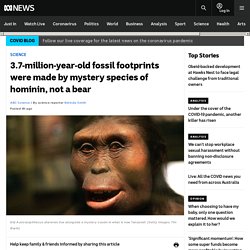
Key points: A set of five fossilised footprints, made by a creature walking on two legs, was found in 1976 Some researchers thought they belonged to a bear, while others suspected a homininNew research rules out the bear hypothesis, but the jury is still out as to what hominin species it is With each small step, their feet sank into a squishy mixture of rain and ash that had fallen from a nearby volcano, leaving a set of footprints behind. The indentations solidified like cement and were covered by another layer of ash, which also hardened and sealed the tracks away.
Then over the millennia, that top layer slowly wore away, bringing the footprints to the surface again and leading to their initial discovery in the 1970s. Which hominin exactly, we don't know, said Ellison McNutt from the University of Ohio, who led the study. Newly identified armoured dinosaur Stegouros elengassen had tail like Aztec weapon, scientists say.
More than half a millennium ago, Aztec warriors brandished a weapon called a macuahuitl, a wooden club with jagged obsidian blades embedded on its sides, to inflict gruesome injuries on enemies in close combat.
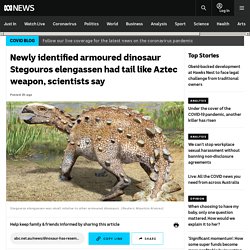
The creature exemplifies the evolutionary arms race during the age of dinosaursStegouros lived in what is now South America's southernmost tip during the Cretaceous periodIts tail was relatively short, with fewer vertebrae than other armoured dinosaurs A newly identified armoured dinosaur that inhabited the Patagonian region of Chile did much the same thing to ward off predators about 74 million years ago with a tail resembling a macuahuitl, scientists said on Wednesday. The four-legged, plant-eating creature, named Stegouros elengassen, exemplifies the arms race that unfolded during the age of dinosaurs to acquire new traits to survive in a perilous world. Decorated ivory 'pendant' carved from mammoth tusk is oldest example of ornate jewellery in Eurasia, archaeologists say. About 41,500 years ago, a Stone Age artist in Europe carved an oval-shaped object covered in dots out of the tusk of a woolly mammoth.
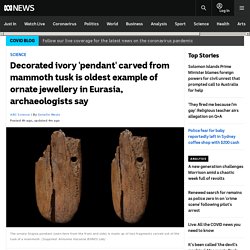
Key points: Archaeologists have directly dated fragments of bone decorated with dotsThey say it is the oldest known piece of decorated jewellery in Eurasia created by modern humansAn Australian expert believes it may be something even more intriguing When placed together, the two 4.5-centimetre-long incomplete fragments appear to make up a pendant, according to an international team of archaeologists. "When you see the piece, it is amazing," said Sahra Talamo of the University of Bologna. The series of dots on the two fragments of ivory may count the number of animals hunted, or keep track of the Moon or Sun.
Whatever their meaning, the piece is the earliest-known decorated jewellery created by modern humans in Eurasia, according to Professor Talamo and colleagues in a study published today in Scientific Reports. Australia's oldest known eagle fossil uncovered on shore of dry lake in SA. Patiently watching and waiting, an eagle suddenly swoops from its tree branch perch onto an unsuspecting possum and, clutching its prey, flies off to feed.
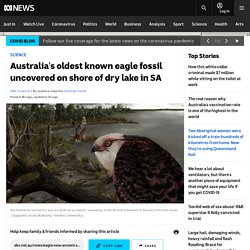
Key points: Palaeontologists in South Australia discovered 63 bones belonging to an eagle that lived 25 million years agoThe eagle had short wings and long legs for its body, suggesting it was a forest-dwelling ambush hunterIts name, Archaehierax sylvestris, means "ancient hawk of the forest" This scene of an ambush in a lush forest took place 25 million years ago; its protagonist, Australia's hitherto oldest-known eagle, Achaehierax sylvestris, or "ancient hawk of the forest". The eagle's bones were discovered on the shore of a dry lake in the South Australian desert by a Flinders University team, who pieced the newly discovered species together. The partial skeleton was unveiled today in the journal Historical Biology. Fossil footprints prove humans populated the Americas around 23,000 ago. Humans reached the Americas thousands of years earlier than previously thought via a land bridge that connected Siberia with Alaska, a team of scientists have said.
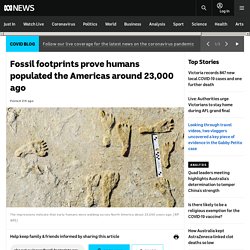
Key points: The tracks were dated using radiocarbon datingTracks of mammoth, giant ground sloth, dire wolves and birds are all present at the site as wellUntil now, scientists believed humans travelled to the Americas about 16,500 years ago Researchers working in the US state of New Mexico found scores of human footprints dated to between 23,000 and 21,000 years old. The footprints were created by children, teenagers and the occasional adult walking through soft mud beside an ancient lake in an area that is now part of the White Sands National Park. Researchers from the US Geological Survey dated these tracks using radiocarbon dating. Canadian scientists unveil Titanokorys gainesi, a giant arthropod that ruled ocean floor 500 million years ago. About 506 million years ago, a strange marine creature whose body so resembled a science-fiction spacecraft that it has been dubbed 'the mothership' thrived in tropical seas, menacing prey on the ocean floor in what is now Canada, as one of Earth's largest predators to that point in time.
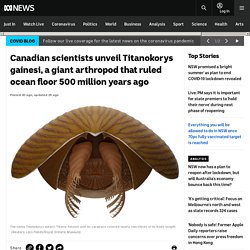
Canadian scientists discovered partial fossils of the Titanokorys gainesi between 2014 and 2018The research has just been published, providing more detail about the anthropod which was giant for its timeResearchers believe Titanokorys may have swum something like a modern stingray, undulating the flaps along the side of its body Scientists announced the discovery of fossils of a Cambrian Period arthropod named Titanokorys gainesi in Kootenay National Park in the Canadian Rockies, within a vast rock formation called the Burgess Shale.
The name Titanokorys means "titanic helmet," and for good reason. New dating technique could reveal Australian rock art rivals the world's oldest. A new scientific dating technique used on a mineral layer coating Kimberley rock art shelters shows the rock carvings may be up to 43,000 years old — among the oldest in the world.

Key points: A new dating technique is able to date a mineral layer on the surface of Kimberley rock art sitesThe oldest dates of the mineral layer are 43,000 years oldIf the mineral layer covering rock carvings proves as old, it will be among the world's oldest dated human art The layer sits like a shiny glaze on the surface of rocks in the shallow caves, according to Helen Green, a research fellow in rock art dating at the University of Melbourne and part of a team that has worked with the Balangarra Aboriginal people.
"We've been able to actually date these glazes, we found they have internal layering, and we've been able to date the individual layers," Dr Green said. Fossil tusk reveals travels of woolly mammoth across Alaska 17,000 years ago during the ice age. If you found yourself standing in Alaska during the last ice age, chances are you would meet a woolly mammoth on the move.
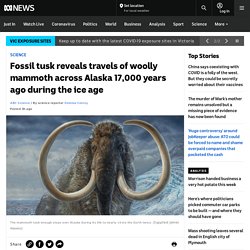
Key points: Scientists have analysed a woolly mammoth tusk that's around 17,000 years oldThey analysed the tusk's chemical signatures to chart the mammoth's movements over its 28-year lifeStudying extinct species can offer clues about what led to their demise. The discovery of pterosaur fossil shows prehistoric reptile was close to 'a real-life dragon' Scientists have discovered a new species of a prehistoric flying reptile in outback Queensland, describing it as the closest thing we have to Australia's very own dragon.
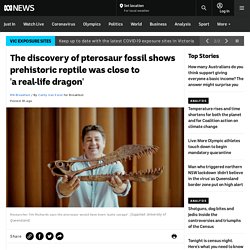
The pterosaur, named Thapunngaka shawi, is the largest of its kind found in Australia. With an estimated wingspan of seven metres, the reptile once soared above the vast ancient Eromanga sea, which covered much of western Queensland during the age of the dinosaurs. University of Queensland (UQ) researchers have published their findings in the Journal of Vertebrate Paleontology. The pterosaur fossil — a lower jaw bone — was discovered in a quarry near Richmond in 2011 by Len Shaw, a local fossicker who had been "scratching around" in the area for decades. Mr Shaw recognised it as something significant and called scientists at Richmond's Kronosaurus Korner marine fossil museum to excavate it. Fossil reveals giant underwater killing machine that once called outback Australia home. Rewind 460 million years to a time when most of Australia was under water and aquatic creatures swam freely above what is now the dry dusty landscape of Central Australia.
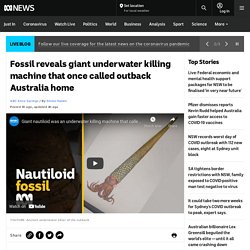
Key points: The Central Australian landscape was once a vast ocean and home to the Endoceras, an oversized killing machine which preyed on fish species and trilobitesThe giant nautiloid was about two-and-a-half metres longIt propelled itself at vast speeds through the water 460 million years ago during the Ordovician period Dr Adam Yates, senior curator of Earth Sciences for the Museum and Art Gallery of the Northern Territory, said that it was a time before any dinosaurs or any animal with a backbone lived on land. Fossil bones belonging to mysterious ancient human found in Israel.
Thousands of years ago a mysterious human spent their days hunting and making stone tools in the area that is now Israel. They looked a little like Neanderthals, and nothing like modern humans who were also living in the region at the time. So who were they? Key points: Archaeologists discovered fragments of a human skull and jawbone at a site outside of Ramla in IsraelThe bones were dated to be between 120,000 to 140,000 years old and are from an unknown ancient humanThis ancient human lived alongside modern humans and may have bred with Neanderthals The bones of an ancient human suggest that they could be related to a distinct group that lived in the area long before their modern relatives rocked up, according to a study published today in Science.
But it is possible the ancestors of this individual may have bred with Neanderthals and the last of their kind mingled with their modern human neighbours. Coronavirus epidemic broke out in East Asia around 25,000 years ago, gene study shows. Coronaviruses have sparked some massive disease outbreaks in living memory, but we've actually been battling them for millennia, according to a new study.
Key points: Scientists have found evidence of an ancient coronavirus outbreak in the genome of modern humans from East AsiaA virus that interacts with human cells and tissues in a similar way to the virus that causes COVID-19 drove the outbreakThe findings could help researchers find new ways to fight COVID-19. A new species of giant rhino discovered in China lived 26 million years ago and was roughly the size of four African elephants.
A new species of ancient giant rhino has been discovered and it would have weighed 21 tonnes, or roughly the equivalent of four large African elephants. Researchers say their analysis points to an entirely new species that was different to other known giant rhinosThe hornless giant's head could reach 7 metres tall, making it taller than a giraffeThe discovery of the animal suggests the giant travelled north through Asia via the Tibetan Plateau Scientists in north-western China made their conclusions about Paraceratherium linxiaense after examining a group of 26 million-year-old fossils found in 2015. The hornless creature's head could have reached 7 metres tall, making it taller than a giraffe and allowing it to graze treetops throughout the woodland areas of the period.
"Its head can reach a height of 7 metres to browse leaves of treetops. " In the study published in Nature, the researchers say their analysis points to an entirely new species that was different to other known giant rhinos. Sharks were nearly completely wiped out 19 million years ago. When palaeobiologist Elizabeth Sibert set out to build a record of fish and shark populations over millions of years, she didn't expect to be solving a mysterious disappearance case. Key points: Shark populations were abundant and diverse for 40 million yearsUp to 90 per cent of global shark populations were wiped out 19 million years ago during a stable and uneventful periodSharks have not recovered from the mass extinction, offering lessons for conserving global shark populations that live today Tiny shark and fish fossils collected from the bottom of the ocean showed that sharks ruled the oceans for some 40 million years, their numbers 10 times higher than they are today.
How do palaeontologists remove fossils from rock? With acid, power tools and plenty of patience. Ancient bones and teeth gleam under bright lights in the Melbourne Museum, surrounded by throngs of excited children — and more than one captivated adult. But beneath this hustle and bustle, in the building's basement, is where such fossils are broken out of their rocky tombs and cleaned up for display and scientific research. Space to play or pause, M to mute, left and right arrows to seek, up and down arrows for volume. Oldest known human burial site in Africa uncovered by archaeologists. Rare fossil sites in the Flinders Ranges one step closer to gaining World Heritage status.
Dinosaur species newly discovered in Chile's Atacama desert once roamed amid lush greenery. Scientists in Chile's parched Atacama desert, the world's driest, have discovered the remains of a previously unknown species of dinosaur that, millions of years ago, lived among lush greenery there. The so-called titanosaur had a small head and long neck and tail, as well as an unusually flat back compared with others like itThe discovery is rare, though several species have been found in Argentina and Brazil, further eastThe dinosaur's remains will eventually be exhibited in Chile's Museum of Natural History. Neanderthal DNA extracted from cave dirt shows population movements 100,000 years ago.
Some 100,000 years ago, deep in a cave in what is now northern Spain, a Neanderthal female lived — and maybe died. Kangaroo-bone tools found in Riwi cave in the Kimberley are thought to be 35,000 years old. Ancient Aboriginal technology unearthed in rare bone discovery on Ngarrindjeri country. A rare glimpse into ancient Aboriginal technology has been uncovered in the form of a bone artefact on Ngarrindjeri country, along the Lower Murray river system in South Australia. Oldest-known Australian rock art is 17,300-year-old kangaroo in the Kimberley, wasp nests show. Million-year-old DNA from mammoth teeth found in Siberia is oldest genome ever sequenced. Ancient Queensland fish 'close living relative' to humans, scientists believe. Scientists have cracked the world's largest animal genome to better understand the evolution of life on land.
Key points: 45,500-year-old rock painting of pigs in Indonesia is the oldest-known art depicting real, recognisable objects. More than 45,500 years ago, perched on a ledge at the back of an Indonesian cave, an artist was at work. Remains of well-preserved Ice Age woolly rhino found in Siberia. Pterosaurs evolved from small, wingless reptiles called lagerpetids, fossils suggest - ABC News. Dinosaur footprint fossil discovery brings new insight into how they roamed Central Queensland - ABC News. The opal fossils that changed a miner's life and introduced a new species from Australia's deep past - ABC News.
Archaeologists discover ancient skull of distant human cousin Paranthropus robustus - ABC News. Canadian boy finds fossils critical to the study of the hadrosaur, or duck-billed dinosaur - ABC News. Ikaria wariootia, a worm found fossilised in SA's Flinders Ranges, is our oldest known ancestor - ABC News. Ancient Aboriginal site Moyjil could rewrite the global story of human migration - ABC News. Stonehenge megaliths' origin tracked by scientists to West Woods site 25 kilometres away - ABC News. Woolly mammoth skeleton found well-preserved in lake in Russia's Arctic - ABC News. Erawondoo Hill is added to the National Heritage List to protect its zircon crystals, the oldest minerals on Earth - ABC News. Fossilised bones of rare 'delicate' dinosaur elaphrosaur identified in a first of its kind in Australia - ABC News.
Ikaria wariootia, a worm found fossilised in SA's Flinders Ranges, is our oldest known ancestor. Historic haul of Australian amber fossils includes ants, spiders and fornicating flies - Science - ABC News. Skull of a toddler is the oldest known fossil of the earliest human, Homo erectus - Science - ABC News. How Gunditjmara words and traditions hold stories of Victoria's rich volcanic history. Teeth from 50-tonne megalodon sharks found in abundance in north-west WA. Traditional owners aghast after Uluru cave painting vandalised with vegetable oil.
Australian lion species discovered in Queensland's Riversleigh World Heritage area. Volcanoes in Victoria reveal fresh evidence of eruptions 37,000 years ago. Scientists identify billion-year-old Chinese seaweed, possibly the oldest green plant fossil ever found. Neanderthal skeleton unearthed at 'flower burial' site in Iraq holds clues about ancient death rites - Science News - ABC News. Brachiosaurus bone 2 metres long excavated in Utah with help of horses - Science News - ABC News. Budj Bim Cultural Landscape fire reveals new sections of ancient aquatic system. Skeletal remains found on Mackay riverbank likely to be human, Queensland police say. New findings from Australia's Wolfe Creek Crater shows large meteorites 'like a nuclear bomb' hit Earth every 180 years. Indonesian 44,000-year-old cave art is earliest known record of 'storytelling', researchers say. Neanderthals commonly suffered from surfer's ear - Science News - ABC News. Riversleigh fossil deposit, acclaimed by Sir David Attenborough, still giving up its secrets.
Partial skull found in Greece shows modern humans were in Eurasia 210,000 years ago - Science News - ABC News. Indigenous ranger's quest to preserve Simpson Desert knowledge and 60,000-year-old history of his people. Diprotodon giant wombat fossil discovered in regional NSW, being examined by Australian Museum. Lake Mungo mysteries captivate students as archaeologists try to solve 50,000-year-old questions. Fossils of giant new species of sea creature found on South Australia's Kangaroo Island. Dinosaur fossils are available for sale on eBay. so why did it take America's national museum so long to get a Tyrannosaurus rex? Fossil nuts from ancient Gondwanan beech tree challenge plant evolution - Science News - ABC News. 'We used to smash them up': How opal mining led to a haul of dinosaur bones at Lightning Ridge. Archaeologists find oldest Scandinavian human DNA in ancient chewing gum.
15-million-year-old fossil reveals skinks had crushing jaw, rounded teeth. New Zealand man discovers ancient moa footprints while taking dogs for a swim. Mary Anning inspired 'she sells sea shells' — but she was actually a legendary fossil hunter - RN. Ice Age fossils and 12,000-year-old human skeleton found in Mexican underwater cave. Fossil jawbone found in cave on Tibetan Plateau may be Denisovan - Science News - ABC News.
Giant carnivore fossil found in museum drawer by palaeontologist on his lunch break - Science News - ABC News. Early human fossil remains found in Philippines cave may herald new species — Homo luzonensis - Science News - ABC News. Stonehenge and the battle over a $3 billion tunnel under one of the world's most famous prehistoric sites. Researchers uncover 66-million-year-old fish fossils from the day the dinosaurs died. Tyrannosaurus rex found in Canada is largest-ever and 'lived a violent life' Landmark hepatitis study tracks ancient human movements into Australia. New wallaby-sized dinosaur identified from fossils found along Victorian coast - Science News - ABC News. How Winton's dinosaur footprints were saved from the Queensland floods.
Neanderthals and Denisovans lived in same Siberian cave for 100,000 years - Science News - ABC News. Cave diver finds prehistoric bones in 'new room' of underwater cave network. Complete skeleton of 'Tasmanian devil on steroids' reveals secrets of Australian 'stealth predator' - Science News - ABC News. Stone mask from the Neolithic era found in the West Bank. Mungo Man is home, but where should he rest? Calls for a memorial for the oldest Australian ever discovered. Scientists dig into rich, remote Bullock Creek fossil site for first time in 16 years.
Documentary sheds light on robbing of Indigenous remains 'in the name of science' Fossilised fat confirms Earth's oldest known animal - Science News - ABC News. Ancient virus lurking in remote Australia, affecting thousands of Aboriginal adults. Oldest-known hashtag made by Stone Age humans in Africa - Science News - ABC News. Croatian discovery pushes the date of cheese-making back 4,000 years. Antarctic adventurers call for heavy-duty horsepower to aid ancient ice quest. DNA reveals ancient girl from Siberia had Neanderthal mother and Denisovan father - Science News - ABC News.
Human skull sparks DNA hunt to identify dozens of unmarked remains in remote Australia. Blue whale skeleton to get new home in WA Museum after a painstaking restoration process. Homo erectus died out due to lack of planning, lazy gathering strategies: ANU research. Pygmy people in Indonesia not related to 'hobbit' but evolved short stature independently - Science News - ABC News. Iceman's stomach contents give a glimpse of what people ate in Copper Age. Ancient pygmy right whale fossil identified 60 years after being found on Melbourne beach.
The Tarn Shelf in Tasmania's Mount Field National Park is a window to the Cretaceous Period - Science News - ABC News. Indigenous languages come from just one common ancestor, researchers say. Extinct gibbon discovered in ancient Chinese tomb first ape to vanish after the Ice Age - Science News - ABC News. Ancient DNA shows first farmers in South-East Asia migrated from China 4,500 years ago - Science News - ABC News.
Virus afflicting thousands of Indigenous Australians to receive 'rapid action', Health Minister Greg Hunt signals.